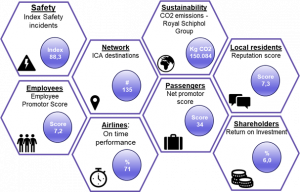Today I spoke to a sustainability manager of a company about steering on impact. Originally, the idea of this inspired manager was that sustainability should also be included in the considerations of a business case.  In everyday practice, sustainability comes as the icing on the cake, alongside the budgetary considerations that weigh heavily for this organisation. But most cakes are eaten without the cherry in the organisation.
In everyday practice, sustainability comes as the icing on the cake, alongside the budgetary considerations that weigh heavily for this organisation. But most cakes are eaten without the cherry in the organisation.
How do you integrate the sustainable ambitions of a company into the management framework of an organisation? I have experienced the transition to this impact management in various companies. The most structured was my experience at Schiphol Group. With the start of a new CEO, Dick Benschop, a new course was set. Mapping the most important stakeholders of the organisation was an essential step. For Schiphol there were 5 main stakeholder groups: airlines, passengers, local residents, employees and shareholders. The interests of these 5 most important stakeholder groups have to be balanced in decision making and use of resources. In addition, three overarching themes that can be seen as a license to operate were identified, namely safety, connectivity (the countries with which Schiphol connects the Dutch and European hinterland) and sustainability. For these 5 stakeholder groups + 3 themes it was determined which metrics could best represent the interest of this stakeholder group. Not easy to have only 1 measurement value. This of course leads to a lot of discussion. Moreover, the measurement value must be measurable on a regular basis, so that you can adjust it. Experience teaches us that a combination KPI is actually too complex to include in the own organisation. It must also be an appealing one. For safety, think of the # of days on which there have been no incidents.
For Schiphol we combined these top indicators in 1 report, which ended up on the management table every month. An integrated picture, therefore, in which the perspectives of the organisation are brought together.
In many annual reports, we already try to make our connection with stakeholders transparent in this way. In various companies, I have also incorporated this into the internal steering method. The most important subjects add the most value for the stakeholders of such an integrated management company. That is true multiple value creation. After all, it is no longer just about the financial considerations, but in connection with customer satisfaction, sustainability or safety. The most important added value for an organisation that has embedded this in its organisation is the improved cooperation based on a common language and shared focus.

